Lancia Thema 2012 User Manual

Handbook

WHY CHOOSE
GENUINE PARTS
We really know your car because we invented, designed and built it: we know every single detail. At
Lancia Service authorised workshops you can find technicians who are trained by us, offering quality and professionalism for all your service requirements.
Lancia workshops are always close to you for your servicing operations, repairs and seasonal checks and our experts will offer practical recommendations for keeping your car in the best possible condition.
When you use Genuine Parts you keep the reliability, comfort and performance features of your new car over time.
Always ask for Genuine Parts and insist on them being fitted to your car. We recommend them because we know they are derived from our continued commitment to research and development and our use of highly innovative technologies.
For these reasons, you can rely on Genuine Parts because they are the only ones designed specifically for your car.


All our Genuine Parts undergo rigorous testing, both in design and build stages, by specialists who check the use of cutting-edge materials and test their reliability.
This guarantees performance and safety in the long term for both you and the passengers in your automobile. Always insist on a Genuine Part and check that it has been used.

Dear Customer,
Thank you for choosing LANCIA and congratulations on your choice of a LANCIA Thema.
We have written this handbook to help you get to know all your car and use it in the best possible way. You should read it right through before taking to the road for the first time.
You will find information, tips and important warnings regarding the driving of your car to help you get the most from the technological features of your LANCIA.
Carefully read the warnings and indications marked with the following symbols: personal safety;
car safety;
environmental protection.
The enclosed Warranty Booklet lists the services that LANCIA offers to its customers:
•the Warranty Certificate with terms and conditions for maintaining its validity
•the range of additional services available to LANCIA customers.
Enjoy the read. Happy motoring!
This Owner Handbook describes all versions of the LANCIA Thema; please consider only the information relevant to your version, engine and configuration.

1
2
3
4
5
6
7
8
9
TABLE OF CONTENTS
INTRODUCTION . . . . . . . . . . . . . . . . . . . . . . . . . . . . . . . . . . . . . . . . . . . . . . . . . . . . . . . . . . . . . . . . . . . 3
THINGS TO KNOW BEFORE STARTING YOUR VEHICLE . . . . . . . . . . . . . . . . . . . . . . . . . . . . . . . . . . . . 9
UNDERSTANDING THE FEATURES OF YOUR VEHICLE . . . . . . . . . . . . . . . . . . . . . . . . . . . . . . . . . . |
. 59 |
UNDERSTANDING YOUR INSTRUMENT PANEL . . . . . . . . . . . . . . . . . . . . . . . . . . . . . . . . . . . . . . . . . |
153 |
STARTING AND OPERATING . . . . . . . . . . . . . . . . . . . . . . . . . . . . . . . . . . . . . . . . . . . . . . . . . . . . . . . . |
191 |
WHAT TO DO IN EMERGENCIES . . . . . . . . . . . . . . . . . . . . . . . . . . . . . . . . . . . . . . . . . . . . . . . . . . . . |
253 |
MAINTAINING YOUR VEHICLE . . . . . . . . . . . . . . . . . . . . . . . . . . . . . . . . . . . . . . . . . . . . . . . . . . . . . . 269
MAINTENANCE SCHEDULES . . . . . . . . . . . . . . . . . . . . . . . . . . . . . . . . . . . . . . . . . . . . . . . . . . . . . . . 309
INDEX . . . . . . . . . . . . . . . . . . . . . . . . . . . . . . . . . . . . . . . . . . . . . . . . . . . . . . . . . . . . . . . . . . . . . . . . . 319
1
2

1
INTRODUCTION
• INTRODUCTION . . . . . . . . . . . . . . . . . . . . . . . . . . .4
• IMPORTANT NOTICE. . . . . . . . . . . . . . . . . . . . . . . .4
• HOW TO USE THIS MANUAL . . . . . . . . . . . . . . . . .6
• WARNINGS AND CAUTIONS . . . . . . . . . . . . . . . . . .7
• VEHICLE IDENTIFICATION NUMBER . . . . . . . . . .7
• VEHICLE MODIFICATIONS/ALTERATIONS . . . . . .7
3
INTRODUCTION
Congratulations on selecting your new LANCIA vehicle. Be assured that it represents precision workmanship, distinctive styling, and high quality - all essentials that are traditional to our vehicles.
Before you start to drive this vehicle, read this Owner's Manual and all the supplements. Be sure you are familiar with all vehicle controls, particularly those used for braking, steering, and transmission shifting. Learn how your vehicle handles on different road surfaces. Your driving skills will improve with experience, but as in driving any vehicle, take it easy as you begin. Always observe local laws wherever you drive.
NOTE: After reviewing the owner information, it should be stored in the vehicle for convenient referencing and remain with the vehicle when sold.
Failure to operate this vehicle correctly may result in loss of control or a collision.
Operating this vehicle at excessive speeds or while intoxicated may result in loss of control, collision with other vehicles or objects, going off the road, or overturning; any of which may lead to serious injury or death. Also, failure to use seat belts subjects the driver and passengers to a greater risk of injury or death.
To keep your vehicle running at its best, have your vehicle serviced at recommended intervals by an authorized dealer who has the qualified personnel, special tools, and equipment to perform all service.
The manufacturer and its distributors are vitally interested in your complete satisfaction with this vehicle. If you encounter a service or warranty problem, which is not resolved to your satisfaction, discuss the matter with your dealer's management.
Your authorized dealer will be happy to assist you with any questions about your vehicle.
IMPORTANT NOTICE
ALL MATERIAL CONTAINED IN THIS PUBLICATION IS BASED ON THE LATEST INFORMATION AVAILABLE AT TIME OF PUBLICATION APPROVAL. THE RIGHT IS RESERVED TO PUBLISH REVISIONS AT ANY TIME.
This Owner's Manual has been prepared with the assistance of service and engineering specialists to acquaint you with the operation and maintenance of your new vehicle. It is supplemented by a Warranty Information Booklet and various customer-oriented documents. You are urged to read these publications carefully. Following the instructions and recommendations in this Owner's Manual will help assure safe and enjoyable operation of your vehicle.
After you have read the Owner’s Manual, it should be stored in the vehicle for convenient reference and remain with the vehicle when sold.
The manufacturer reserves the right to make changes in design and specifications, and/or to make additions to
4
or improvements in its products without imposing any obligations upon itself to install them on products previously manufactured.
The Owner's Manual illustrates and describes the features that are standard or available as extra cost options. Therefore, some of the equipment and accessories in this publication may not appear on your vehicle.
NOTE: Be sure to read the Owner's Manual first before driving your vehicle and before attaching or installing parts/accessories or making other modifications to the vehicle.
In view of the many replacement parts and accessories from various manufacturers available on the market, the manufacturer cannot be certain that the driving safety of your vehicle will not be impaired by the attachment or
installation of such parts. Even if such parts are officially-approved (for example, by a general operating permit for the part or by constructing the part in an officially approved design), or if an individual operating permit was issued for the vehicle after the attachment or installation of such parts, it cannot be implicitly assumed that the driving safety of your vehicle is unimpaired. Therefore, neither experts nor official agencies are liable. The manufacturer only assumes responsibility when parts, which are expressly authorized or recommended by the manufacturer, are attached or installed at an authorized dealer. The same applies when modifications to the original condition are subsequently made on the manufacturer's vehicles.
Your warranties do not cover any part that the manufacturer did not supply. Nor do they cover the cost of any
repairs or adjustments that might be caused or needed because of the installation or use of non-manufacturer parts, components, equipment, materials, or additives. Nor do your warranties cover the costs of repairing damage or conditions caused by any changes to your vehicle that do not comply with the manufacturers specifications.
Original parts and accessories and other products approved by the manufacturer, including qualified advice, are available at your authorized dealer.
When it comes to service, remember that your authorized dealer knows your vehicle best, has the factorytrained technicians and genuine parts, and is interested in your satisfaction.
Copyright © FIAT Group Automobiles S.p.A.
5

HOW TO USE THIS
MANUAL
Consult the Table of Contents to determine which section contains the information you desire.
Since the specification of your vehicle depends on the items of equipment ordered, certain descriptions and illustrations may differ from your vehicle's equipment.
The detailed index at the back of this Owner's Manual contains a complete listing of all subjects.
Consult the following table for a description of the symbols that may be used on your vehicle or throughout this Owner's Manual:
6
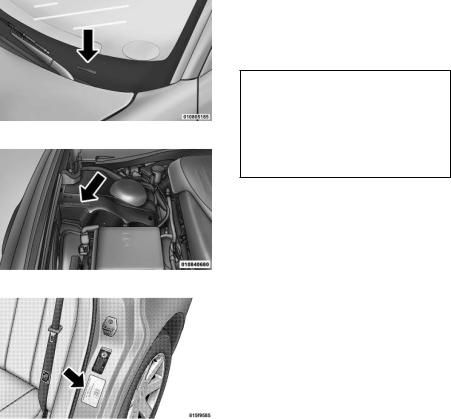
WARNINGS AND
CAUTIONS
This Owners Manual contains WARNINGS against operating procedures that could result in a collision or bodily injury. It also contains CAUTIONS against procedures that could result in damage to your vehicle. If you do not read this entire Owners Manual, you may miss important information. Observe all Warnings and Cautions.
VEHICLE
IDENTIFICATION
NUMBER
The vehicle identification number (VIN) is on the left front corner of the instrument panel. The VIN is visible from outside of the vehicle through the windshield. The VIN is also located on the right front strut tower inside the engine compartment and printed on a label that is affixed to the left rear C-Pillar.
VIN Location
VIN Location
VIN Location
VEHICLE
MODIFICATIONS/
ALTERATIONS
WARNING!
Any modifications or alterations to this vehicle could seriously affect its roadworthiness and safety and may lead to a collision resulting in serious injury or death.
7
8

|
2 |
THINGS TO KNOW BEFORE STARTING |
|
YOUR VEHICLE |
|
• A WORD ABOUT YOUR KEYS . . . . . . . . . . . . . |
. . .12 |
• KEYLESS IGNITION NODE (KIN) . . . . . . . . |
. . .12 |
• KEY FOB . . . . . . . . . . . . . . . . . . . . . . . . . . . . |
. .12 |
• IGNITION OR ACCESSORY ON MESSAGE . . . |
. .13 |
• SENTRY KEY® . . . . . . . . . . . . . . . . . . . . . . . . . |
. .13 |
• REPLACEMENT KEYS . . . . . . . . . . . . . . . . . |
. .14 |
• CUSTOMER KEY PROGRAMMING . . . . . . . . |
. .14 |
• GENERAL INFORMATION . . . . . . . . . . . . . . . |
. .14 |
• VEHICLE SECURITY ALARM . . . . . . . . . . . . . . |
. .15 |
• REARMING OF THE SYSTEM . . . . . . . . . . . . |
. .15 |
• TO ARM THE SYSTEM. . . . . . . . . . . . . . . . . . |
. .15 |
• TO DISARM THE SYSTEM . . . . . . . . . . . . . . . |
. .15 |
• PREMIUM SECURITY SYSTEM |
|
(for versions/markets, where provided) . . . . . . . |
. .16 |
• TO ARM THE SYSTEM. . . . . . . . . . . . . . . . . . |
. .16 |
• TO DISARM THE SYSTEM . . . . . . . . . . . . . . . |
. .17 |
• SECURITY SYSTEM MANUAL OVERRIDE. . . |
. .17 |
• ILLUMINATED ENTRY |
|
(for versions/markets, where provided) . . . . . . . |
. .17 |
9

• REMOTE KEYLESS ENTRY (RKE) . . . . . . . . . |
. . .18 |
• TO UNLOCK THE DOORS . . . . . . . . . . . . . . . |
. .18 |
• TO LOCK THE DOORS. . . . . . . . . . . . . . . . . . |
. .19 |
• TO UNLATCH THE TRUNK . . . . . . . . . . . . . . |
. .19 |
• TRANSMITTER BATTERY REPLACEMENT |
. . .19 |
• GENERAL INFORMATION . . . . . . . . . . . . . . . |
. .20 |
• DOOR LOCKS . . . . . . . . . . . . . . . . . . . . . . . . . . |
. .20 |
• MANUAL DOOR LOCKS . . . . . . . . . . . . . . . . . |
. .20 |
• POWER DOOR LOCKS . . . . . . . . . . . . . . . . . |
. .21 |
• CHILD-PROTECTION DOOR LOCK |
|
SYSTEM — REAR DOORS . . . . . . . . . . . . . . . |
. .21 |
• KEYLESS ENTER-N-GO™ . . . . . . . . . . . . . . . . |
. .22 |
• WINDOWS . . . . . . . . . . . . . . . . . . . . . . . . . . . . |
. .24 |
• POWER WINDOWS . . . . . . . . . . . . . . . . . . . . |
. .24 |
• WIND BUFFETING . . . . . . . . . . . . . . . . . . . . |
. .26 |
• TRUNK LOCK AND RELEASE . . . . . . . . . . . . . . |
. .26 |
• TRUNK SAFETY WARNING . . . . . . . . . . . . . . . . |
. .27 |
• TRUNK EMERGENCY RELEASE . . . . . . . . . . |
. .27 |
• OCCUPANT RESTRAINTS . . . . . . . . . . . . . . . . . |
. .27 |
• LAP/SHOULDER BELTS . . . . . . . . . . . . . . . . |
. .29 |
• LAP/SHOULDER BELT UNTWISTING |
|
PROCEDURE . . . . . . . . . . . . . . . . . . . . . . . . . |
. .31 |
• SEAT BELTS IN PASSENGER SEATING |
|
POSITIONS . . . . . . . . . . . . . . . . . . . . . . . . . . |
. .32 |
• AUTOMATIC LOCKING RETRACTOR |
|
MODE (ALR) . . . . . . . . . . . . . . . . . . . . . . . . . |
. .32 |
10

• SEAT BELT PRETENSIONERS . . . . . . . . . . . . |
.33 |
• ACTIVE HOOD SYSTEM |
|
(for versions/markets, where provided) . . . . . . . |
33 |
• ENHANCED SEAT BELT USE REMINDER |
|
SYSTEM (BeltAlert®) . . . . . . . . . . . . . . . . . . . . |
35 |
• SEAT BELTS AND PREGNANT WOMEN . . . . . . |
36 |
• SUPPLEMENTAL RESTRAINT |
|
SYSTEM (SRS) — AIR BAGS . . . . . . . . . . . . . . . |
36 |
• Air Bag Deployment Sensors And Controls . . . . . |
41 |
• CHILD RESTRAINTS . . . . . . . . . . . . . . . . . . . . |
46 |
• ENGINE BREAK-IN RECOMMENDATIONS . . . . . . |
55 |
• Additional Requirements For Diesel Engine . . . . |
55 |
• SAFETY TIPS . . . . . . . . . . . . . . . . . . . . . . . . . . . . |
56 |
• Transporting Passengers . . . . . . . . . . . . . . . . . . |
56 |
• Exhaust Gas . . . . . . . . . . . . . . . . . . . . . . . . . . . |
56 |
• Safety Checks You Should Make Inside The |
|
Vehicle . . . . . . . . . . . . . . . . . . . . . . . . . . . . . . . |
57 |
• Periodic Safety Checks You Should Make |
|
Outside The Vehicle . . . . . . . . . . . . . . . . . . . . . . |
58 |
11
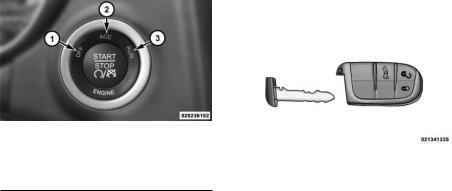
A WORD ABOUT YOUR KEYS
Your vehicle uses a keyless ignition system. This system consists of a Key Fob with Remote Keyless Entry (RKE) transmitter and a Keyless Ignition Node (KIN).
Keyless Enter-N-Go™ Feature
This vehicle is equipped with the Keyless Enter-N-Go™ feature, (refer to "Keyless Enter-N-Go" in "Things To Know Before Starting Your Vehicle" for further information).
KEYLESS IGNITION NODE (KIN)
This feature allows the driver to operate the ignition switch with the push of a button, as long as the Remote Keyless Entry (RKE) transmitter is in the passenger compartment.
The Keyless Ignition Node (KIN) has four operating positions, three of which are labeled and will illuminate when in position. The three positions
are OFF, ACC, and ON/RUN. The fourth position is START. During start RUN will illuminate.
NOTE: In case the ignition switch does not change with the push of a button, the RKE transmitter (Key Fob) may have a low or dead battery. In this situation a back up method can be used to operate the ignition switch. Put the nose side (side opposite of the emergency key) of the Key Fob against the ENGINE START/STOP button and push to operate the ignition switch.
Keyless Ignition Node (KIN)
1 — OFF
2 — ACC (ACCESSORY)
3 — ON/RUN
KEY FOB
The Key Fob also contains the Remote Keyless Entry (RKE) transmitter and an emergency key, which stores in the rear of the Key Fob.
The emergency key allows for entry into the vehicle should the battery in the vehicle or the Key Fob go dead. The emergency key is also for locking the glove box. You can keep the emergency key with you when valet parking.
To remove the emergency key, slide the mechanical latch on the back of the Key Fob sideways with your thumb and then pull the key out with your other hand.
Emergency Key Removal
NOTE: You can insert the doublesided emergency key into the lock cylinders with either side up.
12

IGNITION OR ACCESSORY ON MESSAGE
Opening the driver's door when the ignition is in ACC or ON (engine not running), a chime will sound to remind you to cycle the ignition to OFF. In addition to the chime, the ignition or accessory on message will display in the cluster.
NOTE: With the Uconnect Touch™ system, the power window switches, radio, power sunroof (for versions/ markets, where provided), and power outlets will remain active for up to 10 minutes after the ignition is cycled to the OFF position. Opening either front door will cancel this feature. The time for this feature is programmable. Refer to “Uconnect Touch™ Settings” in “Understanding Your Instrument Panel” for further information.
WARNING!
•When leaving the vehicle, always remove the Key Fob from the vehicle and lock your vehicle.
•Never leave children alone in a vehicle, or with access to an unlocked vehicle.
•Allowing children to be in a vehicle unattended is dangerous for a number of reasons. A child or others could be seriously or fatally injured. Children should be warned not to touch the parking brake, brake pedal or the shift lever.
•Do not leave the Key Fob in or near the vehicle, or in a location accessible to children, and do not leave Keyless Enter-N-Go™ in the ACC or ON/RUN mode. A child could operate power windows, other controls, or move the vehicle.
•Do not leave children or animals inside parked vehicles in hot weather. Interior heat build-up may cause serious injury or death.
CAUTION!
An unlocked car is an invitation to thieves. Always remove the Key Fob from vehicle, cycle the ignition OFF and lock all doors when leaving the vehicle unattended.
SENTRY KEY®
The Sentry Key® Immobilizer System prevents unauthorized vehicle operation by disabling the engine. The system does not need to be armed or activated. Operation is automatic, regardless of whether the vehicle is locked or unlocked.
The system uses a Key Fob with Remote Keyless Entry (RKE) transmitter, a Keyless Ignition Node (KIN) and a RF receiver to prevent unauthorized vehicle operation. Therefore, only Key Fobs that are programmed to the vehicle can be used to start and operate the vehicle.
After placing the ignition in the ON/ RUN position, the Vehicle Security
13

Light will turn on for three seconds for a bulb check. If the light remains on after the bulb check, it indicates that there is a problem with the electronics. This condition will result in the engine being shut off after two seconds.
If the Vehicle Security Light turns on during normal vehicle operation (vehicle running for longer than 10 seconds), it indicates that there is a fault in the electronics. Should this occur, have the vehicle serviced as soon as possible by an authorized dealer.
All of the Key Fobs provided with your new vehicle have been programmed to the vehicle electronics.
REPLACEMENT KEYS
NOTE: Only Key Fobs that are programmed to the vehicle electronics can be used to start and operate the vehicle. Once a Key Fob is programmed to a vehicle, it cannot be programmed to any other vehicle.
CAUTION!
•Always remove the Key Fobs from the vehicle and lock all doors when leaving the vehicle unattended.
•For vehicles equipped with Keyless Enter-N-Go™, always remember to place the ignition in the OFF position.
Duplication of Key Fobs may be performed at an authorized dealer, this procedure consists of programming a blank Key Fob to the vehicle electronics. A blank Key Fob is one that has never been programmed.
NOTE: When having the Sentry Key® Immobilizer System serviced, bring all vehicle Key Fobs with you to the authorized dealer.
CUSTOMER KEY
PROGRAMMING
Programming Key Fobs or RKE transmitters may be performed at an authorized dealer.
GENERAL INFORMATION
The Sentry Key® operates on a carrier frequency of 433.92 MHz. The Sentry Key® Immobilizer system will be used in the following European countries, which apply Directive 1999/5/EC: Austria, Belgium, Czech Republic, Denmark, Finland, France, Germany, Greece, Hungary, Ireland, Italy, Luxembourg, Netherlands, Norway, Poland, Portugal, Romania, Russian Federation, Slovenia, Spain, Sweden, Switzerland, Yugoslavia, and United Kingdom.
Operation is subject to the following conditions:
•This device may not cause harmful interference.
•This device must accept any interference that may be received, including interference that may cause undesired operation.
14
VEHICLE SECURITY ALARM
The Vehicle Security Alarm monitors the vehicle doors, hood and trunk for unauthorized entry and the Keyless Enter-N-Go™ Start/Stop button for unauthorized operation. While the Vehicle Security Alarm is armed, interior switches for door locks and decklid release are disabled. If something triggers the alarm, the Vehicle Security Alarm will provide the following audible and visible signals: the horn will pulse, the park lamps and/or turn signals will flash, and the Vehicle Security Light in the instrument cluster will flash.
REARMING OF THE
SYSTEM
If something triggers the alarm, and no action is taken to disarm it, the Vehicle Security Alarm will turn off the horn after 29 seconds, and turn off all of the visual signals after an additional 31 seconds, then the Vehicle Security Alarm will rearm itself.
TO ARM THE SYSTEM
Follow these steps to arm the Vehicle Security Alarm:
1.Make sure the vehicle ignition system is "OFF". (refer to "Starting Procedures" in "Starting And Operating" for further information).
2.Perform one of the following methods to lock the vehicle:
•Press LOCK on the interior power door lock switch with the driver and/or passenger door open.
•Press the LOCK button on the exterior Passive Entry Door Handle with a valid Key Fob available in the same exterior zone (refer to "Keyless Enter-N-Go™" in "Things To Know Before Starting Your Vehicle" for further information).
•Press the LOCK button on the Remote Keyless Entry (RKE) transmitter.
3. If any doors are open, close them.
TO DISARM THE SYSTEM
The Vehicle Security Alarm can be disarmed using any of the following methods:
•Press the UNLOCK button on the Remote Keyless Entry (RKE) transmitter.
•Grasp the Passive Entry Unlock Door Handle (refer to "Keyless Enter-N-Go™" in "Things To Know Before Starting Your Vehicle" for further information).
•Cycle the vehicle ignition system out of the OFF position by pressing the Keyless Enter-N-Go™ Start/ Stop button (requires at least one valid Key Fob in the vehicle).
NOTE:
•The driver's door key cylinder and the trunk button on the RKE transmitter cannot arm or disarm the Vehicle Security Alarm.
•When the Vehicle Security Alarm is armed, the interior power door lock switches will not unlock the doors.
15
The Vehicle Security Alarm is designed to protect your vehicle; however, you can create conditions where the system will give you a false alarm. If one of the previously described arming sequences has occurred, the Vehicle Security Alarm will arm regardless of whether you are in the vehicle or not. If you remain in the vehicle and open a door, the alarm will sound. If this occurs, disarm the Vehicle Security Alarm.
If the Vehicle Security Alarm is armed and the battery becomes disconnected, the Vehicle Security Alarm will remain armed when the battery is reconnected; the exterior lights will flash, the horn will sound. If this occurs, disarm the Vehicle Security Alarm.
PREMIUM SECURITY SYSTEM (for versions/ markets, where provided)
The Premium Security system monitors the doors, hood latch, and liftgate for unauthorized entry and the ignition switch for unauthorized operation.
The system also includes a dual function intrusion sensor and vehicle tilt sensor. The intrusion sensor monitors the vehicle interior for motion. The vehicle tilt sensor monitors the vehicle for any tilting actions (tow away, tire removal, ferry transport, etc).
In the event that something triggers the security system, the headlights will turn on and the turn signal and side repeater lights will flash for 34 seconds. The system will repeat this sequence for up to 8 security violations in any mode (door ajar, motion, hood ajar, etc.) before having to rearm the system. At the end of any particular trigger event, the lights will continue to flash for 26 seconds.
TO ARM THE SYSTEM
Follow these steps to arm the theft alarm:
1. Make sure the vehicle ignition system is "OFF". (refer to "Starting Procedures" in "Starting And Driving" for further information).
2. Perform one of the following methods to lock the vehicle:
•Press LOCK on the interior power door lock switch with the driver and/or passenger door open.
•Press the LOCK button on the exterior Passive Entry Door Handle with a valid Key Fob available in the same exterior zone (refer to "Keyless Enter- N-Go™" in "Knowing Your Vehicle" for further information).
•Press the LOCK button on the Remote Keyless Entry (RKE) transmitter.
3. If any doors are open, close them.
NOTE:
•Once the security system is armed, it remains in that state until you disarm it by following either of the disarming procedures described. If a power loss occurs after arming the system, you must disarm the system after restoring power to prevent alarm activation.
•The ultrasonic intrusion sensor (motion detector) actively monitors your vehicle every time you
16
arm the security system. If you prefer, you can turn OFF the ultrasonic intrusion sensor and vehicle tilt sensor when arming the security system. To do so, press the LOCK button on the RKE transmitter three times within 5 seconds of arming the system (while the Vehicle Security Light is flashing rapidly).
TO DISARM THE SYSTEM
The Vehicle Security Alarm can be disarmed using any of the following methods:
•Press the UNLOCK button on the Remote Keyless Entry (RKE) transmitter.
•Grasp the Passive Entry Unlock Door Handle with a valid key fob available in the same exterior zone (refer to "Keyless Enter-N-Go™" in "Knowing Your Vehicle" for further information).
•Cycle the vehicle ignition system out of the OFF position by pressing the Keyless Enter-N-Go™ Start/ Stop button (requires at least one valid Key Fob in the vehicle).
NOTE:
•The driver's door key cylinder and the liftgate button on the RKE transmitter cannot arm or disarm the Vehicle Security Alarm.
•When the Vehicle Security Alarm is armed, the interior power door lock switches will not unlock the doors.
The Vehicle Security Alarm is designed to protect your vehicle; however, you can create conditions where the system will give you a false alarm. If one of the previously described arming sequences has occurred, the Vehicle Security Alarm will arm regardless of whether you are in the vehicle or not. If you remain in the vehicle and open a door, the alarm will sound. If this occurs, disarm the Vehicle Security Alarm.
If the Vehicle Security Alarm is armed and the battery becomes disconnected, the Vehicle Security Alarm will remain armed when the battery is reconnected; the exterior lights will flash, the horn will sound. If this occurs, disarm the Vehicle Security Alarm.
SECURITY SYSTEM MANUAL OVERRIDE
The system will not arm if you lock the doors using the manual door lock plunger.
ILLUMINATED ENTRY (for versions/markets, where provided)
The courtesy lights will turn on when you use the Remote Keyless Entry (RKE) transmitter to unlock the doors or open any door.
This feature also turns on the approach lighting in the outside mirrors (for versions/markets, where provided). Refer to “Mirrors” in “Understanding The Features Of Your Vehicle” for further information.
17

The lights will fade to off after approximately 30 seconds or they will immediately fade to off once the ignition is cycled to the ON/RUN position from the OFF position.
NOTE:
•The front courtesy overhead console and door courtesy lights will turn on if the dimmer control is in the "Dome ON" position (extreme top position).
•The Illuminated Entry system will not operate if the dimmer control is in the “Dome defeat” position (extreme bottom position).
REMOTE KEYLESS ENTRY (RKE)
The RKE system allows you to lock or unlock the doors or open the trunk from distances up to approximately 10 m using a hand-held Key Fob with RKE transmitter. The RKE transmitter does not need to be pointed at the vehicle to activate the system.
NOTE: Driving at speeds 8 km/h and above disables the system from responding to all RKE transmitter buttons for all RKE transmitters.
Key Fob With RKE Transmitter
TO UNLOCK THE DOORS
Press and release the UNLOCK button on the RKE transmitter once to unlock the driver's door or twice within five seconds to unlock all doors, if 1st Press Of Key Fob Unlocks is selected in the Uconnect Touch™ System. Refer to “Customer Programmable Features — Uconnect Touch™ System 8.4 Settings” in “Understanding Your Instrument Panel”. The turn signal lights will flash to acknowledge the unlock signal. The illuminated entry system will also turn on.
If the vehicle is equipped with Passive Entry, refer to “Keyless Enter-N- Go™” under “Things To Know Before Starting Your Vehicle” for further information.
Remote Key Unlock, Driver Door/All Doors 1st Press
This feature lets you program the system to unlock either the driver's door or all doors on the first press of the UNLOCK button on the RKE transmitter. To change the current setting, refer to “Uconnect Touch™ Settings” in “Understanding Your Instrument Panel” for further information.
Flash Lights With Lock
This feature will cause the turn signal lights to flash when the doors are locked or unlocked with the RKE transmitter. This feature can be turned on or turned off. To change the current setting, refer to “Uconnect Touch™ Settings” in “Understanding Your Instrument Panel” for further information.
18
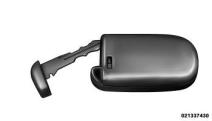
Turn Headlights On With Remote
Key Unlock
This feature activates the headlights for up to 90 seconds when the doors are unlocked with the RKE transmitter. The time for this feature is programmable on vehicles equipped through Uconnect Touch™. To change the current setting, refer to “Uconnect Touch™ Settings” in “Understanding Your Instrument Panel” for further information.
TO LOCK THE DOORS
Press and release the LOCK button on the RKE transmitter to lock all doors. The turn signal lights will flash to acknowledge the signal.
If the vehicle is equipped with Passive Entry, refer to “Keyless Enter-N-Go” under “Things To Know Before Starting Your Vehicle” for further information.
TO UNLATCH THE TRUNK
Press the TRUNK button on the RKE transmitter two times within five seconds to unlatch the trunk.
If the vehicle is equipped with Passive Entry, refer to “Keyless Enter-N-Go” under “Things To Know Before Starting Your Vehicle” for further information.
TRANSMITTER BATTERY REPLACEMENT
The recommended replacement battery is one CR2032 battery.
NOTE:
•Perchlorate Material — special handling may apply. Batteries could contain dangerous materials. Please dispose of them according to respect for environment and local laws.
•Do not touch the battery terminals that are on the back housing or the printed circuit board.
1. Remove the emergency key by sliding the mechanical latch on the back of the RKE transmitter sideways with your thumb and then pull the key out with your other hand.
2. Insert the tip of the emergency key or a #2 flat blade screwdriver into the slot and gently pry the two halves of the RKE transmitter apart. Make sure not to damage the seal during removal.
Prying The Two Halves Of The RKE
Transmitter Apart
3.Remove the battery by turning the back cover over (battery facing downward) and tapping it lightly on a solid surface such as a table or similar, then replace the battery. When replacing the battery, match the + sign on the battery to the + sign on the inside of the battery clip, located on the back cover. Avoid touching the new battery with your fingers. Skin oils may cause battery deterioration. If you touch a battery, clean it with rubbing alcohol.
4.To assemble the RKE transmitter case, snap the two halves together.
19
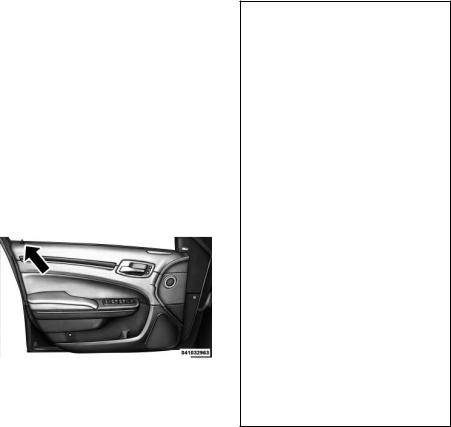
GENERAL INFORMATION
Transmitter and receivers operate on a carrier frequency of 433.92 MHz as required by EEC regulations. These devices must be certified to conform to specific regulations in each individual country. Two sets of regulations are involved: ETS (European Telecommunication Standard) 300–220, which most countries use, and German BZT federal regulation 225Z125, which is based on ETC 300–220 but has additional unique requirements. Other defined requirements are noted in ANNEX VI of COMMISSION DIRECTIVE 95/56/EC. Operation is subject to the following conditions:
•This device may not cause harmful interference.
•This device must accept any interference received, including interference that may cause undesired operation.
If your RKE transmitter fails to operate from a normal distance, check for these two conditions:
1. A weak battery in the RKE transmitter. The expected life of the battery is a minimum of three years.
2. Closeness to a radio transmitter such as a radio station tower, airport transmitter, and some mobile or CB radios.
DOOR LOCKS
MANUAL DOOR LOCKS
To lock each door, push the door lock knob on each door trim panel downward. To unlock the front doors, pull the inside door handle to the first detent. To unlock the rear doors, pull the door lock knob on the door trim panel upward.
Door Lock Knob
If the door lock knob is down when you shut the door, the door will lock. Therefore, make sure the Key Fob is not inside the vehicle before closing the door.
WARNING!
•For personal security and safety in the event of an accident, lock the vehicle doors before you drive as well as when you park and leave the vehicle.
•When leaving the vehicle, always remove the key fob and lock your vehicle.
•Never leave children alone in a vehicle, or with access to an unlocked vehicle.
•Allowing children to be in a vehicle unattended is dangerous for a number of reasons. A child or others could be seriously or fatally injured. Children should be warned not to touch the parking brake, brake pedal or the shift lever.
•Do not leave the key fob in or near the vehicle, and do not leave Keyless Enter-N-Go in the ACC or ON/RUN mode. A child could operate power windows, other controls, or move the vehicle.
20
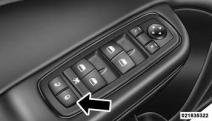
POWER DOOR LOCKS
A power door lock switch is on each front door trim panel. Use this switch to lock or unlock the doors.
Power Door Lock Switch
The doors can also be locked and unlocked with the Keyless Enter-N-Go (Passive Entry) system. For further information, refer to “Keyless Enter- N-Go” in “Things To Know Before Starting Your Vehicle”.
If you press the power door lock switch while the ignition is in the ACC or ON/RUN position, and any front door is open, the power locks will not operate. This prevents you from accidentally locking the Key Fob in the vehicle. Cycling the ignition to the
OFF position or closing the door will allow the locks to operate. If a door is open, and the ignition is in the ACC or ON/RUN position, a chime will sound as a reminder to remove the Key Fob.
Automatic Door Locks
When enabled, the door locks will lock automatically when the vehicle's speed exceeds 24 km/h. The auto door lock feature can be enabled or disabled by your authorized dealer per written request of the customer. Please see your authorized dealer for service.
Automatic Unlock Doors On Exit
The doors will unlock automatically on vehicles with power door locks if:
1.The Automatic Unlock Doors On Exit feature is enabled.
2.The transmission was in gear and the vehicle speed returned to 0 km/h.
3.The transmission is in NEUTRAL or PARK.
4.The driver door is opened.
5.The doors were not previously unlocked.
6.The vehicle speed is 0 km/h.
Automatic Unlock Doors On Exit
Programming
To change the current setting, refer to “Uconnect Touch™ Settings” in “Understanding Your Instrument Panel” for further information.
NOTE: Use the Automatic Unlock Doors On Exit feature in accordance with local laws.
CHILD-PROTECTION DOOR LOCK SYSTEM — REAR DOORS
To provide a safer environment for small children riding in the rear seats, the rear doors are equipped with Child-Protection Door Lock system.
21
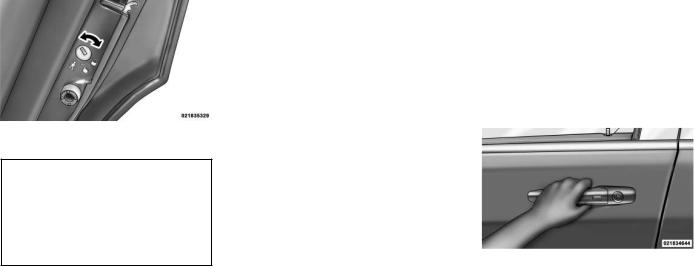
To Engage Or Disengage The
Child-Protection Door Lock
System
1.Open the rear door.
2.Insert the tip of the emergency key into the lock and rotate to the LOCK or UNLOCK position.
3.Repeat steps 1 and 2 for the opposite rear door.
Child-Protection Door Lock Function
WARNING!
Avoid trapping anyone in a vehicle in a collision. Remember that the rear doors can only be opened from the outside when the Child-Protection locks are engaged (locked).
NOTE: For emergency exit from the rear seats when the ChildProtection Door Lock System is engaged, manually raise the door lock knob to the unlocked position, roll down the window, and open the door using the outside door handle.
KEYLESS ENTER-N-GO™
The Passive Entry system is an enhancement to the vehicle’s Remote Keyless Entry (RKE) system and a feature of Keyless Enter-N-Go™. This feature allows you to lock and unlock the vehicle’s door(s) without having to press the RKE transmitter lock or unlock buttons.
NOTE:
•Passive Entry may be programmed ON/OFF; refer to “Uconnect Touch™ Settings” in “Understanding Your Instrument Panel” for further information.
•If wearing gloves on your hands, or if it has been raining on the Passive Entry door handle, the
unlock sensitivity can be affected, resulting in a slower response time.
•If the vehicle is unlocked by the RKE transmitter or Passive Entry and no door goes ajar within 60 seconds, the vehicle will re-lock and will arm the theft alarm.
To Unlock From The Driver's Side:
With a valid Passive Entry RKE transmitter within 1.5 m of the driver's door handle, grab the front driver door handle to unlock the driver's door automatically. The interior door panel lock knob will raise when the door is unlocked.
Grabbing The Driver's Door Handle
22
NOTE: If “Unlock All Doors 1st Press” is programmed all doors will unlock when you grab hold of the front driver’s door handle. To select between “Unlock Driver Door 1st Press” and “Unlock All Doors 1st Press”, refer to “Uconnect Touch™ Settings” in “Understanding Your Instrument Panel” for further information.
To Unlock From The Passenger
Side:
With a valid Passive Entry RKE transmitter within 1.5 m of the passenger door handle, grab the front passenger door handle to unlock all four doors automatically. The interior door panel lock knob will raise when the door is unlocked.
NOTE: All doors will unlock when the front passenger door handle is grabbed regardless of the driver’s door unlock preference setting (“Unlock Driver Door 1st Press” or “Unlock All Doors 1st Press”).
Preventing Inadvertent Locking Of
Passive Entry RKE Transmitter In
Vehicle
To minimize the possibility of unintentionally locking a Passive Entry RKE transmitter inside your vehicle, the Passive Entry system is equipped with an automatic door unlock feature which will function if the ignition switch is in the OFF position.
If one of the vehicle doors is open and the door panel switch is used to lock the vehicle, once all open doors have been closed the vehicle checks the inside and outside of the vehicle for any valid Passive Entry RKE transmitters. If one of the vehicle's Passive Entry RKE transmitters is detected inside the vehicle, and no other valid Passive Entry RKE transmitters are detected outside the vehicle, the Passive Entry System automatically unlocks all vehicle doors and chirps the horn three times (on the third attempt ALL doors will lock and the Passive Entry RKE transmitter can be locked in the vehicle).
NOTE: The vehicle will only unlock the doors when the doors are locked using the door panel switch, a valid Passive Entry RKE transmitter is detected inside the vehicle, and no valid Passive Entry RKE transmitter is detected outside the vehicle. The vehicle will not unlock the doors when any of the following conditions are true:
•The doors are locked using the RKE transmitter.
•The doors are locked using the LOCK button on the Passive Entry door handles.
•The doors are manually locked using the door lock knobs.
•There is a valid Passive Entry RKE transmitter outside the vehicle and within 1.5 m of either Passive Entry door handle.
•Three attempts are made to lock the doors using the door panel switch and then close the doors.
23

To Enter The Trunk
With a valid Passive Entry RKE transmitter within 1.0 m of the deck lid, press the button on the right side of CHMSL, (Center High Mounted Stop Light) which is located on the deck lid.
To Lock The Vehicle’s Doors
With one of the vehicle’s Passive Entry RKE transmitters within 1.5 m of the driver or passenger front door handles, press the door handle LOCK button to lock all four doors.
The vehicle doors can also be locked by using the RKE transmitter lock button or the lock button located on the vehicle’s interior door panel.
WINDOWS
POWER WINDOWS
The window controls on the driver's door control all the door windows.
Trunk Passive Entry Button
NOTE: If you inadvertently leave your vehicle's Passive Entry RKE transmitter in the trunk and try to close the deck lid, the deck lid will automatically unlatch, unless another one of the vehicle’s Passive Entry RKE transmitters is outside the vehicle and within 1.0 m of the deck lid.
Outside Door Handle Lock Button
NOTE:
•After pressing the door handle LOCK button, you must wait two seconds before you can lock or unlock the doors, using either Passive Entry door handle. This is done to allow you to check if the
vehicle is locked by pulling the door handle, without the vehicle reacting and unlocking.
•The Passive Entry system will not operate if the RKE transmitter battery is dead.
Power Window Switches
There are single window controls on each passenger door trim panel, which operate the passenger door windows. The window controls will operate only when the ignition is in the ACC or ON/RUN position.
24
